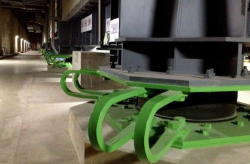Ding ding ding ding!Welcome, ladies and gentlemen, to the most exciting fight we have seen in years! In the left corner, we have the champion, the Shaking Shaman, the Trembling Terror . . . the earthquake! This fighter has yet to be beaten by man. And in the right corner! We have . . . a building. Built by man, and standing a great 30 stories tall, the building has lost every fight to the earthquake in the past. It should be a short fight today, folks. Buildings have just never been able to stand up to earthquakes.
ROUND 1! DING DING DING!And it should be a short one. Building stands in the ring, doing nothing. Just standing. When the earthquake comes in and really shakes things up! It trembles! It rocks! But the building does not go down! What is happening? To
absorb means to take in and hold. Just like a sponge takes in water, the building is absorbing a lot of the earthquake's shaking. This is not the building we have known from past fights! It is not going down! This building is made of parts that move around and don't just break in half. It's taking all the hits! What's going on here?!

Which color sponge absorbs best?
In the past, this building was fixed to the ground, so when the earthquake started moving the floor, the shaking went straight up the stone or brick, making cracks and breaking it fast! Tall buildings used to be stuck in the ground, but now something different is happening down there!
Base isolators are springs, pads, or wheels at the bottom of a building that shake with the ground so the rest of the building does not feel as much of it. From where I am sitting, folks, I see pads at the bottom of the building that are pressing and stretching, taking a lot of the shaking from the earthquake so the rest of the building does not have to! Clearly, this building has not been skipping leg day at the gym. Or . . . the people who made this building knew that they could build things at the bottom of it to move with the shaking. It might be the second thing, but I'm pretty sure I've seen this building at the gym before . . .

These things can really spring to life during an earthquake.
ROUND 2! DING DING DING!The earthquake's still shaking, and this fight is far from over. The shaking is too much for the base to take on, and now the building's starting to feel it, folks. It's trembling, it's shaking . . . But wait! No! It's moving back and forth, like a butterfly! Like a bee!
Flexibility is when something can bend so that it will not break. The best fighters know how to dodge and lean, and this building is no different. Instead of being made out of wood and stone, which crack if they bend, this is made of steel and other things that bend and sway. When the shaking starts, the building moves with the ground. What will it do next?!

The "Greatest of all Time" at earthquake prevention.
The last time the building stepped into the ring, it did not know how to move. It just stood still until it cracked, broke and all fell down. This is how people used to make older buildings. Now it seems to be made of different materials. With the new flexible materials, all of that shaking moves out over a lot of the building's space. To
transmit means to move through something instead of keeping it in one place. The way old buildings were made, if just one section shook, it would crack before the shaking moved on to crack something else. Now, we make them so that they shake with the ground, and send the waves through them. This is exciting, folks! This building just won't go down!
ROUND 3! DING DING DING!In the final round, the earthquake is going to give it all its got. It shakes! But the building absorbs the hits into its base isolators, which take all of the shaking so the building will not have to! It quakes! But the building is flexible and transmits the shaking through its whole body instead of just taking it all into one part that would crack! The building is still standing, and . . . The earthquake has left the building! It's stopped shaking the ground. It's over, folks! The building wins!
Reference:
How Stuff Works. "How Earthquake-resistant buildings work" Discovery, 2011. <http://science.howstuffworks.com/engineering/structural/earthquake-resistant-buildings4.htm>